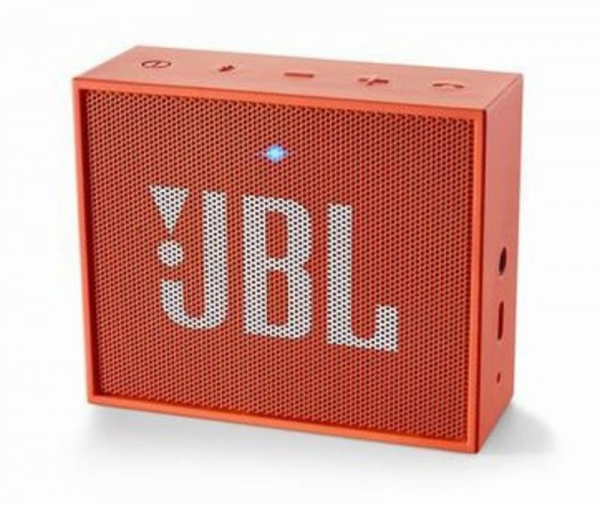JBL
JBL Go: a simple and efficient ultra-portable speaker
Aprox. 21€
See specificationsThe JBL Go is the most compact wireless speaker available from JBL today. Its size and introductory price make it particularly attractive for those who simply want to enjoy their music on the go. One thing is certain, this little enclosure is full of good surprises!
Positive points
Musical and fairly precise sound rendering for a speaker of this size.
Clarity and homogeneity of voices.
Very good size / power ratio.
Very nice autonomy.
Good build quality.
Easy to use.
Bad points
Bass a little too boomy.
Some distortion concerns in the bass past 80% of the volume.
Average microphone quality.
No NFC chip.
No possibility to go back to the previous song.
A single USB cable for accessory.
Our review
Ergonomics
The Go is a small, very simple speaker that fits in your hand. It is covered with a well finished rubber coating. It is available in 8 colors, including the black version of our test. Even if it is not announced as supporting IP standards (water splashes, immersion ...), it can absorb some shocks and some falls without problems. Its front metal grid protects the speaker to a minimum. Unfortunately, no carrying case or wrist strap is provided - although a space is provided for the latter.
Its size (82 x 30 x 68 mm) and its light weight (140 g) allow it to slip everywhere, discreetly. The coating chosen also offers good grip, although it is true that angular edges are not always the most pleasant. Its design and the absence of a passive bass radiator allow it to be used standing or flat on the back. Even if it does not carry an NFC chip, the Go is very easy to take in hand and to connect. The entire pairing process is indicated by light and sound signals. The controls on the top of the speaker boil down to volume, pairing and a final combo button for call management / voice control / pause / play / next song. The latter unfortunately does not allow you to return to the previous song. In addition to Bluetooth, the speaker can also be wired via the 3.5 mm mini-jack connector located next to the micro-USB port for charging. Again, the bare minimum is provided, namely a small USB cable.
With regard to autonomy, JBL promises a duration of use of 5 hours in wireless connection. On the ground, the Go has simply amazed us by taking exactly 10:40 in reading at 75% of the volume; a level of listening largely sufficient indoors and very correct outdoors. We still did a series of tests with another JBL Go, this time at maximum volume: the speaker then only held 5 hours, but we must admit that we will rarely push the volume to this level, especially because that the distortion in the bass flies away. Our only regret is that the speaker does not accurately indicate the battery level.
As is often the case with speakers of this size, the microphone is not really effective. The capture seems distant and it is really necessary to approach (30 cm at least) to be clearly heard by his interlocutor.
Audio
The JBL Go offers a relatively precise and musical sound experience given its size. It still pushes the bass and treble forward by drawing a slight signature in V. It is clear that its size did not suggest acoustic prowess in the bass. The Go does the job fairly well by developing audible bass from 130 Hz. This area is however not well managed: the bass is a bit boomy and tends to invade the midrange up to around 800 Hz. Bass / low mids have difficulty expressing themselves, a bit like being compressed in the speaker. This effect is particularly present when certain sources play a D 3. When one pushes the speaker in its last entrenchments, beyond 80%, the effect is clearly accentuated and the distortion points its nose. We can still enjoy a perfectly correct volume below this threshold, whether for additional listening indoors or outdoors.
Despite this little annoyance, the voices are clearly heard and relatively precise. Their timbre is well respected and the sibilants remain proclaimed, which is very pleasant when listening to songs with very prominent voices, small formations or simply broadcasts / podcasts. The treble, on the other hand, is much more colorful, especially in the extreme treble. This exacerbates the scintillating side of cymbals, for example, and makes the whole thing a little more acidic. Fortunately, this is only really the case when you are right in the center of the speaker; Fortunately a fairly rare situation due to the size and design of the enclosure.
The Go is not the most powerful, but has nothing to envy compared to its direct competitors. The distortion remains very calm except in the bass when you start to reach the maximum volume. We also note that the songs gain a lot of clarity when the scene is lightly loaded with sources or when the mastering is not overly compressed.
Little to say about wireless communication. With around 160 ms of latency, it is done relatively quickly and avoids any discrepancy between sound and image.
Conclusion
If you are looking for a very compact portable speaker, without fuss and with good autonomy to accompany you on the go, the JBL Go seems to be perfect. Its sound performance is also quite honorable given its size. In the same price range, the Philips BT2200 offers better resistance and the Creative Woof 3 more features. The sound quality is not the same ...
Specifications

